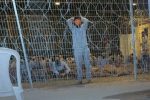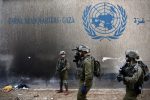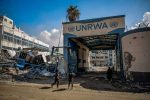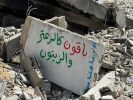Israel is infamous for bombing the innocent in the Gaza Strip. During Israel’s latest three-day military offensive against the besieged enclave on 5 August 49 people including 17 children and four women were killed.
Israeli air and artillery strikes also struck various targets across Gaza that it claimed belonged to Islamic Jihad destroying refugee camps and more than 1500 housing units displacing approximately 450 Palestinians from homes that were completely damaged.
Dubbed “Operation Breaking Dawn” Qatar Red Crescent Society has since launched a “Devotion to Gaza” campaign to collect $2.7m to help rebuild the homes destroyed.
The bloody onslaught on Gaza followed only a year after the 11-day Israeli attack in May 2021 during which civilians were killed and injured tens of thousands displaced homes and vital infrastructure destroyed and the supply of basic services severely disrupted.
Health Centers and media offices as well as schools and mosques were among structures that were targeted. Wheat farms were scorched.
As a result most people took temporary shelter in schools or with friends and family before eventually going back home. However some 1800 families – around 10000 people – remain unable to return.
After the bombing stopped the Palestinian Ministry of Housing in Gaza announced that it suffered $479 million worth of damages and that the losses were suffered in the housing infrastructure development and economic sectors.
Promises of assistance to “rebuild homes and roads” and “support Gaza civilians” poured in much of it directly to UNRWA the UN’s Agency for Palestine refugees.
Adnan Abu Hasna UNRWA’s spokesperson in Gaza said the Agency received $60m from donors to fix and rebuild homes. Notably Egypt and Qatar pledged $500m each for reconstruction.
Moreover Malaysia launched a “unified” fund to support Palestinians in the occupied Gaza Strip.
And although Israel did agree to remove restrictions on the entry of building materials into Gaza last August officials in Gaza argue that Israel continues to pressure donors to not fund reconstruction projects.
The $479 million damage came after the 2020 UN report which revealed that the blockade has pushed more than one million Palestinians in Gaza below the poverty line and cost the enclave $16.9bn.
The UN report came in addition to Gaza’s Ministry of Social Development’s announcement in 2019 that the rates of poverty and unemployment in the Strip reached nearly 75 per cent due to Israel’s two-day onslaught against Gaza in November code-named “Operation Black Belt”.
Israeli officials boasted about their “great victory” over “terror” in the Gaza Strip which caused the death of 34 Palestinians including eight children and three women and wounded 111 others.
Prior to Israel’s “Operation Black Belt” on Gaza the Palestinian Housing Minister announced in February 2019 that 90 per cent of the houses destroyed by Israel during the 2014 military offensive against Gaza had been rebuilt from the millions poured in towards projects helping reconstruct Palestinian homes.
However Gaza’s Ministry of Social Development added in its press release that since Israel’s “Operation Black Belt” on Gaza 70 per cent of the population is food insecure. This it continued was a result of “the aggressive Israeli practices increased since the Second Intifada which broke out in 2000 and depriving thousands of Palestinians of their jobs”.
As a result the Palestinian economy could not “create new jobs to accommodate those untrained workers”.
“The Israeli blockade imposed by Israel on the Gaza Strip since 2006 restricting the movement of citizens and goods in addition to three wars in 2008–2012–2014 and the division of Palestinian forces created a complex and difficult political economic and social reality.”
Also in 2019 following “Operation Black Belt” the Head of the Popular Committee Against the Israeli Siege on Gaza MP Jamal Al-Khodari said that Gaza still needs $280 million to rebuild homes demolished during Israel’s 2014 offensive on the enclave which lasted 51-days and killed 2200 people and caused massive damage to the Strip’s buildings and infrastructure.
Al-Khodari said in a statement that the reconstruction of these homes is a “humanitarian ethical and legal issue” noting that women children and men who used to live in these homes “are currently homeless”.
Watching their homes being bombed and reduced to mountains of debris-scattered holes each time after rebuilding and barely recovering has become a vicious cycle in brutalized Gaza home to more than two million people.
It has been repeatedly proven that the international community issuing statements of concern and donating aid offers very little in the way of resistance to Israel’s 15-year blockade. The UN predicted in 2012 that Gaza would be uninhabitable by 2020. Unfortunately by countless measures the prediction has proved right.
How many more times must Gaza be rebuilt to be bombed again for the international community to understand that the reality is for Gaza to have a future without destruction and suffering a complete end to the inhumane land sea and air blockade imposed by apartheid Israel is the only solution?
The crippling siege on the Gaza Strip is protecting no one except the Israeli regime and its freedom to kill maim and traumatize Palestinians with zero consequences.
– Anjuman Rahman is an experienced journalist with a demonstrated history of working in the information technology and humanitarian industry. Strong media and communication professional graduated from University of the Arts London. Her article appeared in MEMO.












